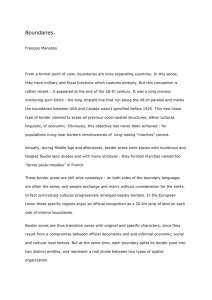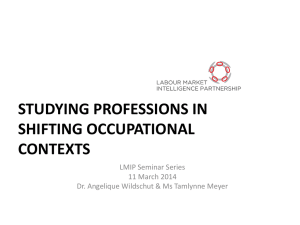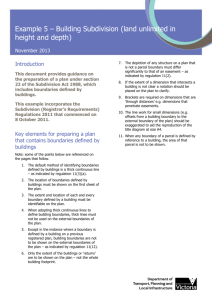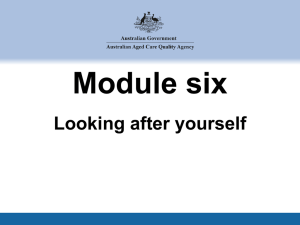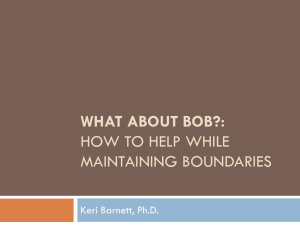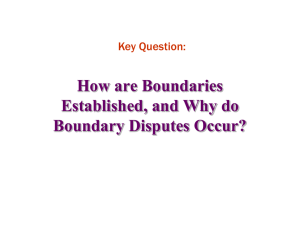Political Geography
advertisement
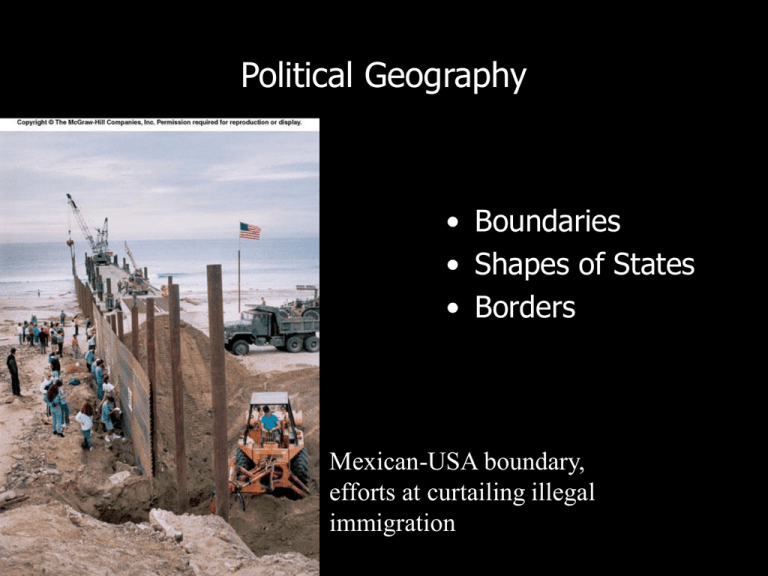
Political Geography • Boundaries • Shapes of States • Borders Mexican-USA boundary, efforts at curtailing illegal immigration Outline • Boundaries • Shapes of States • Borders Political Geography QuickTime™ and a TIFF (LZW) decompressor are needed to see this picture. Boundaries • Natural Boundaries-based on natural features like rivers and mountains • Difficult to determine the height of land or the middle of the river for boundaries Disputed mountain boundary, Argentina-Chile Natural boundaries can pose problems of demarcation….Chile/Argentina River boundaries •Mississippi River defined as border between Tennessee and Arkansas • since 1815, river has meandered, leaving isolated pieces of each US state on the ‘wrong side’ Geometric Boundaries • based on lines of latitude or longitude; or arcs of circles; or other straight lines Northern New Brunswick: arbitrary straight lines Saskatchewan: Latitude & Longitude Labrador boundary dispute • 1902 - Newfoundland government grants a lumber company license to harvest trees on both sides of the Hamilton (now called Churchill) River • Quebec government considered the southern part of the river part of Quebec • 1927 British Privy Council decides in Newfoundland's favour (use of watershed divide from Blanc Sablon to Cape Chidely), strengthened in Confederation (BNA Act, 1949) Labrador boundary ... a line drawn due north from the eastern boundary of the bay or harbour of the Anse au Sablon as far as the fifty-second degree of north latitude, and from thence westward ... until it reaches the Romaine River, and then northward along the left or east bank of that river and its head waters to the source and from thence due northward to the crest of the watershed or height of land there, and from thence westward and northward along the crest of the watershed of the rivers flowing into the Atlantic Ocean until it reaches Cape Chidley. www.collectionscanada.ca/confederation/023001-2980-e.html Geometric Boundaries of Antarctica • Antarctic Treaty signed 1959: basis for government of Antarctica • Governmental matters over Antarctica decided at meetings; 26 states vote • 7 states claim portions of Antarctica as national territory • USA and other nations do not have claims, but have retained the right to make a claim • 1991: 50 year ban on mining activity Four Corners Geometric Boundary:Utah/Arizona/Colorado/ New Mexico Antecedent & Subsequent Boundaries – Antecedent were laid down before most of the cultural landscape was established – Subsequent were laid down after most settlement patterns were developed Antecedent Boundary • Boundary was established in 1818, before most settlement of the Prairies •First Nations were not consulted •Antecedent refers to whose culture? • 49th parallel of latitude was used for most of the western US/Canada boundary • Transportation links developed around the boundary Subsequent boundaries • Drawn after settlement has occurred • Some have be drawn to separate populations along ethnic or religious lines (India/Pakistan) Subsequent boundaries • Consequent Boundaries-drawn to account for cultural patterns eg. Eire/N Ireland • Others drawn with little or no regard for underlying ethnic or cultural patterns e.g., African states vs tribal boundaries (left) Partitioning of Bosnia-Herzegovina: consequent & subsequent boundaries Bosnia –Herzegovina 1991, ethnically Bosnia-Herzegovina 2005, divided: Moslem-Croat divided among Moslems (M), Serbs Federation; Serbian Srpska (S), Croats (C) Maritime Boundaries • Increased importance in 20th century • Islands especially crucial (St. Pierre et Miquelon increases France’s maritime boundary) • United Nations Convention on the Law of the Sea (UNCLOS) widely accepted by 1990. • Still disputes of ownership and boundary baselines all over world. Maritime Boundaries • Territorial Sea- up to 12 nm , exclusive fishing rights • Contiguous Zone- 24 nm immigration and sanitation controls • Exclusive Economic Zone EEZ-200nm. Economic advantage for all resources • High Seas-all states of world. Resources are common heritage Ministates claim 200-mile nautical limit; Gain considerable control of oceans Outline • √Boundaries • Shapes of States • Borders Shapes of states • Compact theoretically the “best” shape • Prorupt - parts become isolated • Elongated narrow and thin • Fragmented isolated parts • Perforated - state surrounded by another. Perforated States • Enclave - a state lying entirely within the boundaries of another state.eg. Lesotho/South Africa • Exclave - a part of a state lying entirely outside its boundaries. Eg. Melilla and Ceuta parts of Spain in Africa. Extra-Territoriality http://www.witness.org/index.php?option= com_rightsalert&Itemid=178&task=view& alert_id=7 • • • How do borders/boundaries affect firms and workers in this situation? How are political geography and economic geography linked? Do you agree with the common assertion about ‘globalization’ that we now live in a ‘borderless world’? Why or why not? Borders and economic alliances Free Trade Area Common Market Economic Union Free Trade Area Map source: http://ucatlas.ucsc.edu/trade/subtheme_trade_blocs.php
